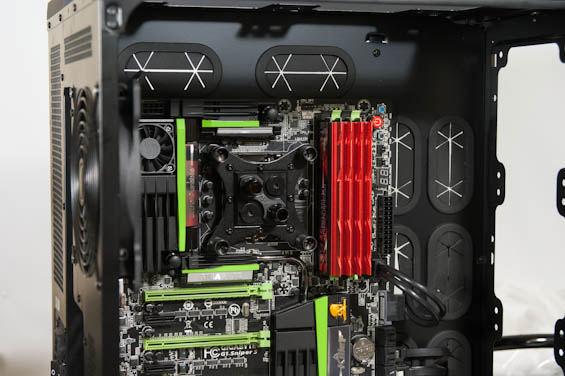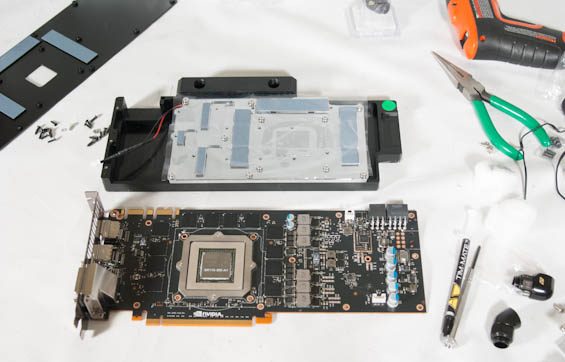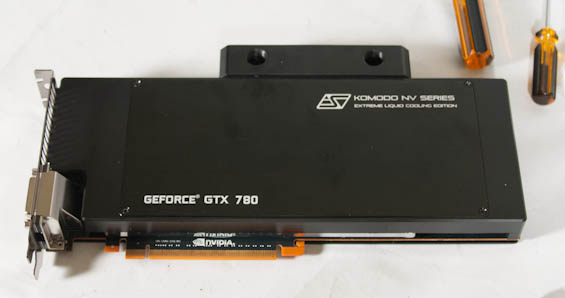The Neophyte's Custom Liquid Cooling Guide: How To, Why To, What To Expect
by Dustin Sklavos on September 30, 2013 12:01 AM ESTNow that you understand what the fittings are, the rest of it is just a matter of going by the plan and adapting as unforeseen issues materialize. There isn't any order you have to connect the individual parts in, just as long as they make a complete loop and you're careful to tighten (but not overtighten) all of the seals. My suggestion is to just connect whatever's easiest and take your time. That said, the easy part and one of the most fun parts is installing the waterblocks.

The CPU waterblock goes on pretty much like any conventional CPU cooler, but without a massive heatsink array getting in the way or even the tubing from a CLC. Because the Apogee HD's two barbs both stick straight up and the area surrounding the CPU socket is typically pretty clear, this is actually fairly easy to install early and connect late.
Installing the GPU waterblock is more involved, but not actually that bad. Disassembling a GeForce GTX 780 (or 680/770/Titan) is simple; the hardest part really is saying farewell to that beautiful stock cooler. The back of the card is going to be nothing but screws; four larger Philips head, one smaller one, and then ~15 small torx screws. You'll have to remove all of them. The stock cooler has two different connectors plugged into the PCB that you'll also need to disconnect.

Once the cooler is removed, use a cotton ball and some rubbing alcohol (90% pure or better) and gently remove the thermal grease from the surface of the GPU die. From there, the included instructions for the waterblock will be very clear and straightforward. The benefit of using a specially designed waterblock like the KOMODO-NV is that the assembly is extremely easy. It's contingent upon your card being a reference board, but the block is designed specifically to fit that board and cool all of the surface components. From the photo above you can even see the thermal padding for the power circuitry and GDDR5 chips.

In my opinion, the video card waterblocks are the biggest upshot of a custom liquid cooling loop. Everything gets cooled properly, the blocks look nice, and you'll see load thermals that are maybe half what the card ran at under air.










106 Comments
View All Comments
egotrippin - Monday, October 14, 2013 - link
I'm about to nerd out so forgive me...
Some of the conclusions from this article aren't representative of what you can truly do with water cooling but rather the limitations of the equipment you selected.
For starters, the addition of a pump doesn't automatically mean more noise. The pump you selected can sound like an angry wind up toy and it generates a lot of heat and vibration. A Laing D5 Vario/MCP 655 pump is whisper quiet, especially with a Koolance PMP450 top on it. It can be running at full speed pushing 4.6 liters per minute through the system and so long as it's decoupled properly from any hard surface in the computer case then you wouldn't be able to hear it if it was 6 inches from your ear.
I run a 3930k overclocked typically to 4.4 GHz although I've done higher and if I'm running prime 95 or Intel burn-test my temps are about 66C TOTAL and not 66 DELTA?! If your room is a comfortable 24 C does that mean your CPU temps are 84C on water? Something isn't right. I don't know that chip but maybe it needs to be Delidded and Lapped. I had that same Apogee HD block before on a 3930k which is a much hotter chip and my temps never reached that high.
The fans you are using have a familiar style... because they look just like the Scythe Gentle Typhoons which have the best noise/static pressure of any radiator fan I've seen tested. If you used Gentle Typhoons, temps would be lower and the whole thing would be quiet.
The coolant you used is probably less efficient than distilled water. The only coolant I've used that delivers lower temperatures is Ice Dragon which is heavy and expensive and cuts your flow rate in half. Distilled water works great and it's $1
I can't tell for sure but it looks like small diameter tubing was used. Using 1/2" inner diameter tubing delivers higher flow which means lower temperatures.
Those radiators are anorexic. I don't think they come much thinner than that. Use something with a bit of heft. My rad is 80mm thick which is twice the thickness of those Swiffys. This allows for substantially more cooling and also higher flow rate which, again, increases cooling and lowers noise.
My 3930k + my GTX 690 dual GPU card can both be overclocked and Folding or benching with all cores/gpus at 100% and it can be silent enough that if it weren't for the power light, you wouldn't know it was on. I briefly used air on my GTX 690 and it sounded like a hair dryer and filled the room with the scent of charred air much like the smell of turning your heater on for the first time in winter.
If anybody reads this, you can expect better results if you buy better components. I started off with Swiftech because they were cheap and also they were carried at my local MicroCenter. I quickly graduated to better parts. The Apogee HD is an excellent water block and the Swiftech MCP35X2 and MCP655 pumps are both excellent pumps (but neither were used here).
prismatics - Wednesday, October 16, 2013 - link
Why did you only post OC Liquid benchmarks? I'm interested in Non-OC liquid numbers. I have no interest in overclocking, I just want the quietest, most efficient system.mc2k4 - Tuesday, December 31, 2013 - link
Terrible article, would put off anyone from watercooling. Those results are horrendous.woogitboogity - Wednesday, January 22, 2014 - link
I did a custom build CPU/Northbridge/GPU with the cooling loop going outside the case to the reservoir about 5 years ago...I will admit that when the thing ACTUALLY worked for a while it was insane... granted it was 5 years ago but even then seeing lukewarm temperatures on essentially every component at full load was pretty impressive.
BUT... I feel that one thing missing from this article is a reality check: I work in experimental physics and I have had to work water cooling and even liquid helium cooling for magnets. 5 years ago the vendors of water cooling hardware implied a LOT more than they could back up in practice... since then their claims have only gotten more extravagant. At least in the days when people did water cooling from scratch they did not have marketeers offering false assurances in the form of warranties that clearly do not cover damage due to other hardware.
BOTTOM LINE: I think the subtext of this entire article that needs to be clear is that custom water cooling should be treated as a VERY expensive hobby. Expect to lose every component... period. If that is not an acceptable outcome don't do it. I say this because I deal with experimental cooling all the time and I got burned by the sub-par cooling hardware offered not too long ago (same hoses and cooling block designs... still using water).
Drittz121 - Friday, February 28, 2014 - link
Just do yourself a favor. STAY AWAY from this company. Yes they look good. But when it breaks and it WILL. All they do is give you the run around. They have had my system for over 2 months trying to fix the garbage they sell. Worse company out there for support. DONT BUYalpha3031 - Sunday, June 22, 2014 - link
What about these new Devils Canyon chips?